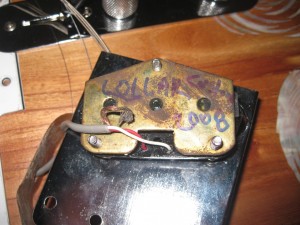Hi Lollar fans! We sometimes get requests to verify the authenticity of Lollar pickups, whether its a set that pops up on eBay, or a used guitar that is said to be stocked with our stuff. Sometime in 2003 or 2004 we standardized how our pickups were marked, and it is still done the same today. The only way to know for sure that you have a genuine Lollar pickup is to check the bottom and look for the proper markings. We label them in a few different ways, from humbuckers to Strats… there are certain things to look for to insure authenticity.
CURRENT PRODUCTION:
HUMBUCKERS: All our humbuckers have tags screwed to the bottom and are stamped with “LOLLAR IMPERIAL” followed by the year, and if it is a neck or a bridge. Color is important as well… a black label is standard wind, grey is a Low Wind, and red is a High Wind. The name of the builder will be initialed in the right bottom corner.
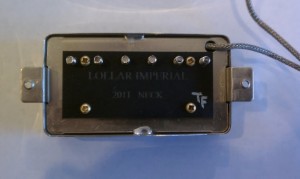
STRATS AND TELES: All of our Strat and Tele style pickups have this info hand written on the bottom: Lollar, the type of pickup (position if it’s a Strat), initials of the builder, and the year it was produced. LOLLAR is also stamped on the top middle on Strats. We use either white or black paint pens to handwrite on our pickups. A few models like Thunderbird and Johnny Smith pickups have black baked on enamel that we apply with a laser.
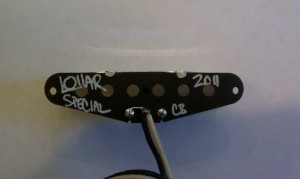
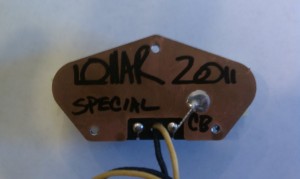
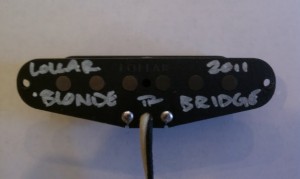
P90s: On our P90 pickups, all the info is stamped like a humbucker, except for our Special winds which are indicated by a hand written label, such as 50’s, -5% or +5%. Same for soapbar or dog ear.
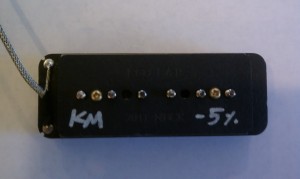
Besides the markings, our overall construction is top notch. If the pickup seems a bit off- not as solid as it should be, it might not be a Lollar. For instance, wax is usually completely wiped off after potting leaving little to no trace, instead of drippy gooey globs all over. We also buff any exposed forbon (like on Tele bridge pickups) so it has a satin sheen instead of dull, matte type finish. Our lead wires on single-coil pickups lay flat, and there are no frays in the cloth wiring. We also tape all of our coils to protect them from damage. We even buff our plastic pickup covers! Our humbuckers come with clear plastic tape over the top to protect the finish on the pickup cover. We only use high quality lead wires.
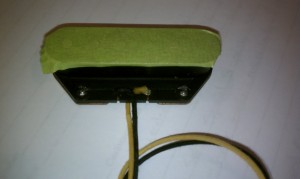
OLD SCHOOL LOLLARS:
If it says Custom on the bottom (along with Lollar and the date) it could be anything- it may not be in phase with anything else we make and it may not match any specs. If you know the name of who originally purchased the custom item we can usually look the job up and see what the specifications were.
Occasionally we get asked questions about pickups for sale on eBay that are supposedly Lollar made. It is rare for people to try to pass off fake, uninstalled pickups for Lollars, but here are a couple photos of horribly made pickups that have Lollar written on the bottom.
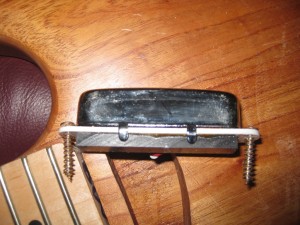
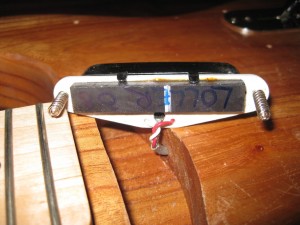
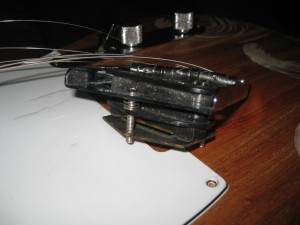
More often, a guitar was sold claiming to have Lollars installed and was purchased by someone and resold. The purchaser had been told Lollars were installed and they never verified it. Even this is not common (but it happens) , so here’s how you can tell…
Going as far back as I can remember (before ’96 or ‘97) the bobbins could have been made out of anything other than vulcanized fiberboard – maybe wood, or often I would make them out of the thin plastic that cassette tape cases were made of- these would be fairly roughly made and would have no markings.
After ‘96 or ‘97 I would have made my bobbins out of vulcanized fiberboard- this is the same material Fender makes their pickups out of. The quality of construction would be quite high, as all of my parts were cut by hand using jigs – everything would be uniform, but nothing would be signed yet unless someone asked me to. You can tell if a P-90 is mine because I have always made the bobbins by hand and after ‘96 or ‘97 they would be made of vulcanized fiberboard.
After my book came out I started to see a few other manufacturers making P-90s using the plan I drew up- vulcanized fiber assembled bobbins. The only time I might use the standard cast plastic bobbin on P-90s would be to restore and old Gibson P-90 that had bobbin rot beyond repair.
Sometime around ‘98 or ‘99 I would have started to write model names on the bottom of pickups and dating them- still no signature unless asked for it. If the pickup in question has a model name that corresponds to something I still make then the specs are the same- same magnets and turn count. If you bought a pickup in 1996 and you buy another one today to match with the old pickup, the new pickup will be in phase with the old one- I never changed that.
Also, if you have an old single coil neck pickup (like a P-90) and you buy a new bridge pickup, not only will it be in phase but the set will be hum cancelling. Around 2001 or 2002 most of my pickups had established model names, and you’ll see the model name either abbreviated or written out on the bottom- usually in paint pen along with the date and my initials or last name.
If all else fails and you are still not sure, take a picture of the bottom and send it to [email protected] and we’ll take a look for you.
